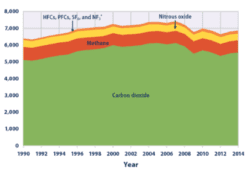This indicator describes emissions of greenhouse gases in the United States.
This indicator focuses on emissions of carbon dioxide, methane, nitrous oxide, and several fluorinated gases—all important greenhouse gases that are influenced by human activities. These particular gases are covered under the United Nations Framework Convention on Climate Change, an international agreement that requires participating countries to develop and periodically submit an inventory of greenhouse gas emissions. Data and analysis for this indicator come from EPA’s annual inventory submission, the Inventory of U.S. Greenhouse Gas Emissions and Sinks: 1990–2014.1 This indicator is restricted to emissions associated with human activities. It starts in 1990, which is a common baseline year for global agreements to track and reduce greenhouse gas emissions.
Each greenhouse gas has a different lifetime (how long it stays in the atmosphere) and a different ability to trap heat in our atmosphere. To allow different gases to be compared and added together, emissions are converted into carbon dioxide equivalents. This step uses each gas’s 100-year global warming potential, which measures how much a given amount of the gas is estimated to contribute to global warming over a period of 100 years after being emitted. Carbon dioxide is assigned a global warming potential equal to 1. This analysis uses global warming potentials from the Intergovernmental Panel on Climate Change’s (IPCC’s) Fourth Assessment Report. In that report, methane has a global warming potential of 25, which means a ton of methane emissions contributes 25 times as much warming as a ton of carbon dioxide emissions over 100 years, and that ton of methane emissions is therefore equal to 25 tons of carbon dioxide equivalents. See the table for comparison with global warming potentials from IPCC’s Fifth Assessment Report. For additional perspective, this indicator also shows greenhouse gas emissions in relation to economic output and population.




